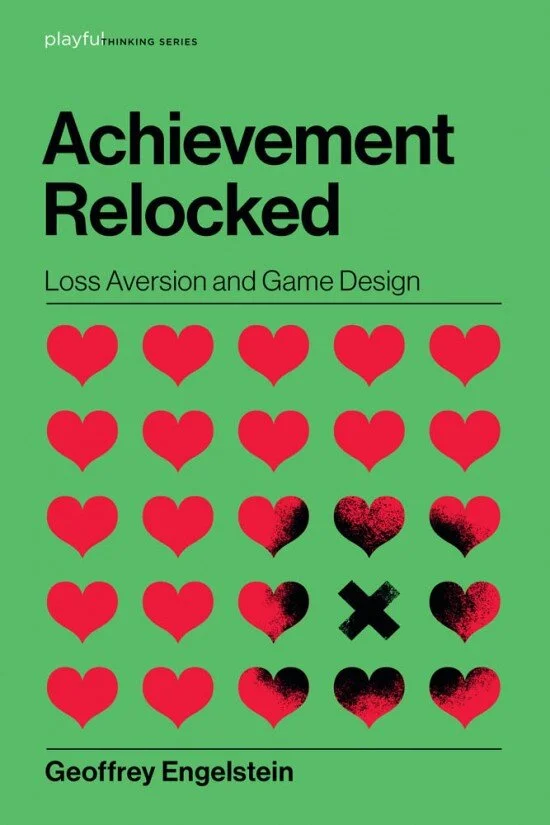Achievement Relocked
Front cover of Geoffrey Engelstein’s book, Achievement Relocked
Achievement Relocked: Loss Aversion and Game Design
Geoffrey Engelstein
MIT Press
ISBN: 9780262043533
Geoffrey Engelstein’s work will be familiar to many readers. He’s a game designer whose credits include Space Cadets (Stronghold Games: 2012), The Fog of War (Stronghold Games: 2016) and The Expanse (Wizkids: 2017); co-founder, with Ryan Sturm, of the Ludology podcast; he teaches game design at the NYU Game Center, and is author of GameTek: The Math and Science of Gaming (Bookbaby: 2017) and, with Isaac Shalev, Building Blocks of Tabletop Game Design (CRC: 2019), a book I reviewed last year. This track record is significant when it comes to Achievement Relocked in both establishing the angle from which it is written, and the audience to which it is directed. In short, this is a book primarily aimed at game designers, written by a practitioner and theorist whose expertise in communicating complex ideas has been developed in both academic and popular media.
As the book’s subtitle indicates, the focus is on loss aversion and the ways in which this impacts both how games are experienced by players and how they might be designed with this experience in mind. Appropriately, the book begins by defining the psychological concept of loss aversion, which is expressed as follows, ‘Losing something makes you feel worse than gaining the same thing makes you feel good’ (5). It’s a concept that Engelstein shows to have significant consequences for decision making and, by extension, for the kinds of decisions that game designers might want to put in front of their players.
The opening chapters of the book explore this concept, drawing on psychological studies that explore our approach to loss. Thus, we’re treated to an enjoyable survey of experiments that demonstrate that people will regularly avoid risk of loss even when, mathematically speaking, they are making choices with lower expectation values. Engelstein’s discussion is underpinned by Daniel Kahneman and Amas Tversky’s important 1979 study ‘Prospect Theory: An Analysis of Decision under Risk’, the findings of which have just been replicated in Kai Ruggeri, Sonia Alí, Marie Louise Berge et al’s ‘Replicating patterns of prospect theory for decision under risk’ (Nature Human Behaviour: 2020).
To give an indication of the work on which Engelstein draws, Kahneman and Tversky asked participants to pick between:
OPTION A: An 80 percent chance of winning $4,000 and a 20 percent chance of winning nothing.
OPTION B: A 100 percent chance of winning $3,000.
The outcome of this experiment, as Engelstein notes, was that 80% chose Option B even when they were told that the expectation value of Option A is $3,200. People, they conclude, seek sure gains over potential losses.
Things get more interesting still when the same question is framed in terms of losing:
OPTION C: An 80 percent chance of losing $4,000 and a 20 percent chance of losing nothing.
OPTION D: A 100 percent chance of losing $3,000.
Here 92% chose option C (an expected loss of $3,200). A comparison which leads Engelstein to conclude that ‘People prefer a sure gain over a gamble for a larger gain, but they will gamble to avoid a sure loss’ (7). Having Engelstein as a guide for this work is a real boon. While it is undeniably useful to go back to the original study, it is enough for this reader to leave Engelstein to summarise the original and to offer his interpretation of the results as they apply to game design (specifically, a philosophy of game design as design for player experience).
Engelstein deploys these insights about loss aversion in a reading of games that explores, in a clear and engaging way, their impact on the experience of play across the book’s seven short chapters. Moving on from the general discussion of loss aversion, the book considers the endowment effect (the additional value given to objects we already possess), framing (the significance of the terms in which often identical choices are couched), utility theory (the value attached to outcomes), endowed progress (the use of loss aversion to generate positive experiences), and regret (the emotional stakes with which we might play). In each case, Engelstein draws on further studies and a range of helpful examples with which to explore his ideas. The examples used work extremely well. In the main they’re well-known games (board and video games) that will be familiar to the target audience (games include: Catan, Deal or No Deal, Civilization, Magic: The Gathering, and Portal) and in the inevitable cases where they are not familiar they are described in enough detail to allow them to exemplify the point at hand.
The result of this carefully balanced combination of theory and examples is a book that is both engaging and instructive. Engelstein’s insights into the motivations behind the ways in which players approach loss and risk, and the attendant suggestions as to how to capitalise on this in game design, are at once thought-provoking and actionable. This last point is significant - passages of bold text spell out the implications of each chapter, leaving little chance that readers will be left asking ‘so what?’ at any point. Achievement Relocked is a fascinating and useful book that will be of great interest to anyone interested in game design, as well as to players interested in understanding some of the impulses behind their own in-game decisions.
References
Kahneman, D., and A. Tversky. ‘Prospect Theory: An Analysis of Decision under Risk.’ Econometrica, 47:2, 1979, pp. 263–291.
Ruggeri, K., Alí, S., Berge, M.L. et al. ‘Replicating patterns of prospect theory for decision under risk.’ Natural Human Behaviour 4, 2020, pp. 622–633
